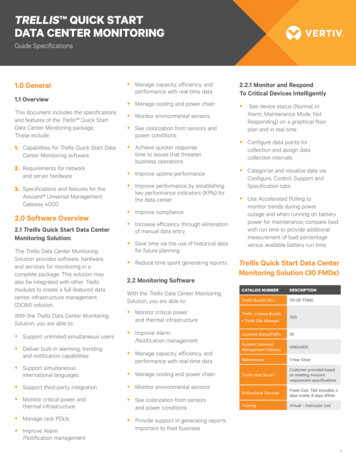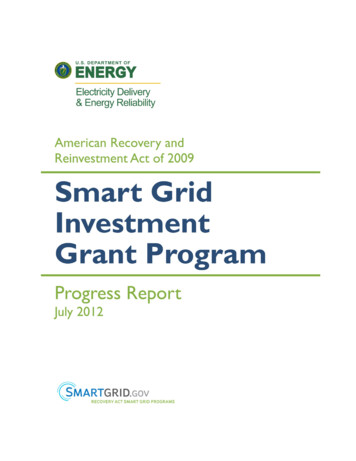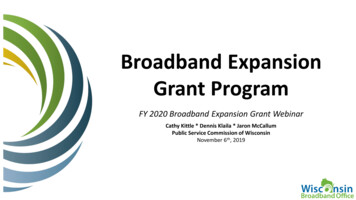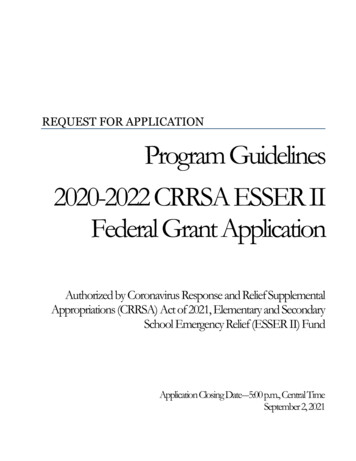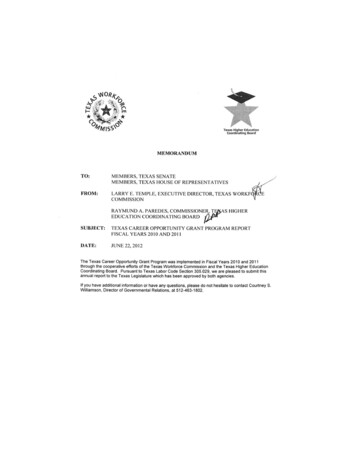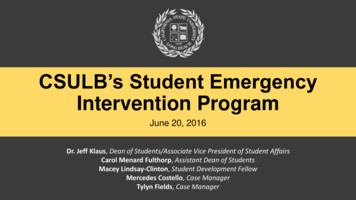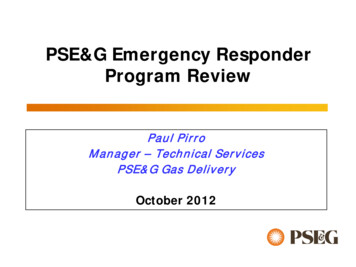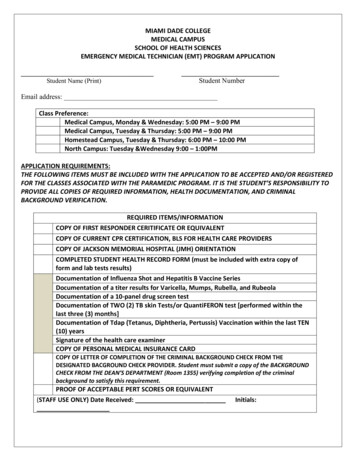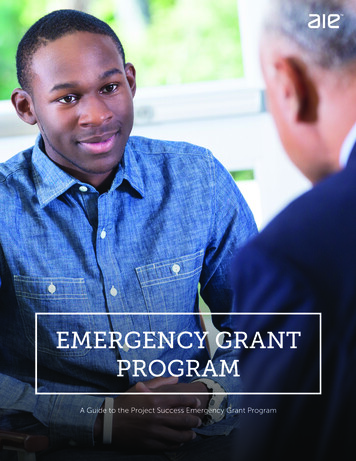
Transcription
EMERGENCY GRANTPROGRAMA Guide to the Project Success Emergency Grant Programwww.aie.org
OVERVIEWThis guide is meant to assist you in completing the “Project Success Emergency Grant ProgramApplication for Academic Year 2018 - 2019” by providing background information about theprogram and context for questions asked on the application. Please submit any questions onapplication content or technical concerns to projectsuccessgrants@trelliscompany.org.For questions on how the Emergency Grant Program complements other components ofProject Success, please contact your Trellis consultant.ABOUT PROJECT SUCCESSIn collaboration with Federal Student Aid, Trellis Company, a nonprofit corporation, works with participatingminority-serving institutions to provide students, faculty, staff, and campus/district leaders with resources,support, and information to address student recruitment, retention, degree completion, and cohort defaultrates. These services are offered at no cost to the institution.ABOUT TRELLISTrellis is a nonprofit company with origins in administration of federal student loan programs. As such,Trellis has more than 30 years of experience working with students, higher education institutions, andcommunity partners to expand educational opportunities and successes for students.PURPOSE OF THE EMERGENCY GRANT PROGRAMTo address student retention challenges, Trellis is offering emergency grant funding for your campus to assiststudents with unforeseen financial need. For many low-income students, an unforeseen expense for somethinglike a car repair or medical bill can create a financial emergency that threatens their college hopes. Whiletypically not large expenses, they can be enough to force these students into a tough choice: stay in collegeor pay the bill. Research has shown that when colleges quickly pay these unforeseen, emergency bills onbehalf of students, more low-income college students stay enrolled and on track for graduation.Referral to Project Success CoachingSchools should encourage students to utilize Trellis’ financial coaching program (after emergency grant fundshave been provided to address a student’s immediate need) to help empower the student to avoid futureemergencies to the extent possible, through a combination of additional planning and accessing communityresources, as appropriate.Trellis coaches use a student-centered approach that encourages critical thinking and planning. Coaching sessionsare individualized to the needs of each student, confidential, delivered virtually (via phone and video), and free.More information about Trellis financial coaching, including an introduction to the coaching staff,resources, student testimonials, and access to our appointment scheduling system, can be foundat http://www.aie.org/coaching.
INSTITUTIONAL ELIGIBILITYInstitutions using at least one other Trellis Project Success service are invited to apply for emergency grantfunding as part of the holistic services offered through Project Success. The award process is non-competitive;awards are approved based on demonstration of a robust program plan meeting all eligibility requirements.Institutions that do not qualify for this award cycle may re-submit in any subsequent cycle, depending onavailability of funding, and should address any reviewer concerns.Selected institutions will agree to adhere to the following programmatic guidelines: Funding amounts are based on tiers correlating to student enrollment. Campuses will receive a 5,000 one-time capacity building award prior to the initial award disbursement.Additional capacity building funding may be available for subsequent years, pending availability of funding andapproval of a renewal application. The capacity award is for the institution’s use to help to set up the program. Schools will administer this program from an office other than the Financial Aid Office. Colleges are strongly encouraged to refer students requesting emergency grants to additional campus,community, and Project Success resources to supplement the grant, address root causes or contributingfactors to the financial emergency, and further support the student’s persistence. Campuses will provide sustainability plans for the grant program, developed in conjunction with their Trellisconsultants, as part of the reporting requirements.TRELLIS’ COMMITMENTIn addition to providing funding for emergency awards, Trellis commits to support your school in thedevelopment of the program by providing: Consultation on defining “emergency” Guidance/templates/best practices to assist in developing the student application, review process,promotional materials and communication plan, etc. Financial coaching to any interested emergency grant applicants (after grant funding approval or denial;coaching will not be a requirement for emergency grant application consideration) Opportunities to learn from peer institutions participating in the Trellis Emergency Grant Programwww.aie.org
INSTITUTIONALAPPLICATION PROCEDUREComplete the Project Success Emergency Grant Program Application for Academic Year 2018 – 2019 andemail it, along with all required attachments, to projectsuccessgrants@trelliscompany.org by noon CDT onthe date provided to you by your Trellis consultant. You will be required to include the following documentsat the time of application: Signature forms: print a hard copy to gather the necessary signatures, and then scan the completeddocument and submit as a PDF A copy of your Student Application; you may use the Trellis Emergency Grant Application template instead If your institution is not located in Texas, a copy of your IRS W-9 form Completed CrushFTP sign-up form Optional for all applicants: additional attachments such as tables and graphs that support your answersto the application questionsBe sure your institution meets all requirements and fully understands how this program works before spendingtime completing the various application materials. Institutional commitment to the program has been key topast grantees’ successes. Begin collaborating right away with the people who will need to provide input on your plans and ultimatelysign-off on your application. This should include your president or chancellor and your colleagues in areasresponsible for budgeting, financial aid, processing payments, and reporting enrollment data to the NationalStudent Clearinghouse. Collaborate with your colleagues in Institutional Research or other relevant departments to complete thereporting documents.What to Expect if Your Application is Approved1. Trellis will email a Grant Agreement to the designated emergency grant program primary contactat your institution.2. Institution will return the completed Grant Agreement to Trellis.3. Trellis will disburse the 5,000 capacity building grant funds on or after July 1, 2018.4. Trellis will make the first (fall term) disbursement of emergency grant funding on or afterSeptember 1, 2018.5. Trellis will make the second (spring term) disbursement of emergency grant funding on or afterJanuary 15, 2019 (conditional upon receipt of fall term report).6. Depending on funding availability, renewal applications and guidelines will be available summer 2019.
REPORTING REQUIREMENTSData Elements to be Reported to TrellisEach January, July, and September, schools are expected to report to Trellis the following data elementsfor students who have received a Trellis emergency grant during the preceding term: Date of birth Support services to which student was referred Gender Term/semester Parent(s) attainment of associate’s degree or higher Year Ethnicity Dependents of student Category of aid (based on categories provided byTrellis on the reporting form, such as utilities,housing/rent, food, medical/dental, personalautomobile expenses, public transportation/buspasses, child care, fuel, etc.) Veteran status Total requested Foster child status Total awarded Application submission date Total denied Award decision date Total paid Institution name Reenrollment data Race Marital status of student Fully paid dateClearinghouse Enrollment Data to be Reported Each SemesterReporting to the National Student Clearinghouse (NSC) each term of enrollment data for all students,including race/ethnicity information, will facilitate more robust datasets and increase the ability ofprofessionals to support all students to completion.Each February and October, schools are expected to provide de-identified NSC enrollment data (graduated,full-time, half-time, less than half-time, withdrew, or session not attended) to Trellis for students who havereceived emergency grants.This reporting will require coordination with the campus office or department responsible for NSC reporting,to ensure that a data request is submitted to the Clearinghouse well in advance of each reporting deadline.www.aie.org
Narrative ReportsTrellis requests that institutions submit narrative reports on program progress and sustainability efforts everyyear via a brief online survey. These reports are a key component of this grant, as the successes and challenges youshare help us to learn more about how to best help students address obstacles to program completion.ADDITIONAL RESOURCES Trellis recorded webinar “Dash Emergency Grant” discusses the structure, success, and best practices of along-term emergency grant program administered by Great Lakes, another GA participating in Project Success Texas Higher Education Coordinating Board’s Emergency Aid Network, including sample application templates Wisconsin Hope Lab publication “Distributing Emergency Aid to College Students: Recommendations andSample Distribution Protocol” (Includes sample application template.)
STUDENT APPLICATIONPROCESS AND PROCEDURESStudents facing financial emergencies are in crisis. Colleges need basic information to pay students’ emergencyexpenses but don’t want to create unnecessary barriers to access through complicated application processes.The easier colleges can make it for students to quickly benefit from emergency funds, the sooner they will returntheir focus to school and move toward completion.STUDENT ELIGIBILITY GUIDELINESAward amounts: Average award anticipated: 500 Preferred award limit: 1,000 Schools may use their discretion to award up to 1,500, if needed. Trellis seeks to serve as many students aspossible; however, award amounts should be sufficient to cover the emergency at hand. Trellis defers to theschool’s discretion.Fund use: Funds should be allocated for unforeseen circumstances only. Funds are intended to be provided on a one-time basis for students. Assistance is intended to support students without other economic resources. Students should demonstratefinancial need; schools will define how this is determined. Funds are not to be used to cover school expenses (parking, fines, tuition, books, supplies, required tools/equipment, etc.). Funds should not be added to a student’s ledger or statement of account.Student status: Must be undergraduate, degree-seeking students enrolled part-time or full-time. Graduate students are not eligible for emergency grants. Must be enrolled during the semester in which emergency grant funds are awarded (students may beeligible for summer funding if they are enrolled in summer classes or they were enrolled in both theprevious and upcoming fall semesters). Trellis Company places no restriction on number of credits earned; schools may include additionalrequirements at their discretion.www.aie.org
THE STUDENT APPLICATIONYou may use the included Trellis Emergency Grant Application template in its entirety, modifying it to includeadditional items as you wish, or you may develop your own application. We recommend you collect the datapoints requested on the student grant disbursement report (template included with your application materials)during the application process to ensure you have all data required to submit the report to Trellis. May be online or hard copy. Should be as brief and student-friendly as possible. Should include documentation of the student’s expense. A few examples: For a car repair, a studentshould provide a mechanic’s estimate. For backup child care, a student should provide a bill from thechild care provider. Request the emergency payment due date on the application; schools should keep in mind that thefunds will need to be disbursed by that date. Collect any data reporting elements (under “Reporting Requirements: Data Elements to be Reportedto Trellis” above) that are not collected elsewhere through institutional processes.YOUR APPLICATION MUST INCLUDE STUDENT WAIVERAUTHORIZING DATA. EXACT LANGUAGE TO USE IS BELOW:By submitting this emergency grant request, I acknowledge and give consentfor data to be shared with the Department of Education and Trellis Company, ortheir representatives, as part of Project Success. I understand that my informationwill not be sold for any purpose and will not be distributed to other parties.Examples of data shared include, but are not limited to: student name and ID,enrollment status, annual income, EFC, emergency request amount, emergencyrequest type, etc.PRINT FULL NAME HERE:Signature:Date:
INTERVENTIONSWe know small grants help low-income students weather financial emergencies and stay in school and oncourse for completion. However, emergency grants are only one piece of the puzzle in helping students stayon track. When students connect with an advisor and other long-term resources, they are more likely to stayenrolled until degree completion. Grantees have found following up with students and offering them theselong-term resources to be an important student success strategy. The student application should include messaging directing students to future resources (post-emergency),such as campus and community resources, public benefits, and financial literacy/planning resources thatcan address the root causes and contributing factors leading to their unforeseen expenses and assist withlong-term planning. As part of the application, we recommend the school:– Meet one-on-one with the student seeking an emergency grant before making the award determinationand ask, “What will you do if you don’t get this funding?” It’s the best way to assess the magnitude of theirfinancial emergency.– Encourage students to meet with a Trellis financial coach, following resolution of the emergency.Students can book a coaching appointment at http://www.aie.org/coaching/.AWARD DETERMINATIONSIt is imperative that schools develop seamless coordination between student support offices and the officedisbursing grant funds, to pay emergency expenses quickly and assist the student in returning his or herattention to their academic commitments. Develop guidelines/evaluation rubric to help ensure consistency in the decisions of review committee:– Establish a definition of “emergency.” Project Success recommends: “A financial emergency is defined asan unforeseen expense that, if not resolved quickly, could lead to the student’s departure from the collegeand loss of momentum toward completion.”– Provide examples of what might and might not qualify. We expect that these examples will grow andevolve as the program progresses; we recommend that you learn from early applications to help refineyour guidelines. Establish a process for reviewing and making an award determination and notifying the student of the approvalor denial within two business days of receiving a completed application and required documentation.www.aie.org
AWARD DISBURSEMENTSStudents face unique pressures and challenges and shouldn’t be judged for the financial circumstances that drivethem to apply for assistance. The goal is to prevent as many students as possible from stopping or dropping outdue to unforeseen expenses. We have seen that it is important for those making award determinations to meetfrequently to calibrate their decisions. Disburse each emergency grant within two business days (see below) of approving it, by either paying thethird party named in the submitted documentation or issuing a gift card (for the specific business to bereimbursed) that can be used to pay the unforeseen expense.– As a reminder: these timing requirements are in place to help ensure that students’ needs are met in anexpedited manner. In considering ways to meet the requirements, keep in mind the ultimate goal. Forexample, even if you are unable to physically deliver a check to an automotive mechanic within two days,as long as you have communicated with the mechanic and they have accepted your assurance that paymentis forthcoming, that would meet the requirement that the student’s emergency was resolved within therequired time period. Payments must not be disbursed to students directly. However, it is acceptable to give students a vendorspecific gift card (such as a grocery store card) that cannot be used for general purposes. General-use orcash-value gift cards (such as Visa gift card) are not allowed.DISBURSEMENT WITHIN TWO BUSINESS DAYSAn emergency, by definition, demands swift action, and the financial emergencies our grant addressesare no different. For grants to have their desired effect—keeping students on track—institutions should actquickly on grant applications and then get funds to the third parties requiring payment.Many schools have questions about establishing processes to facilitate disbursements to third parties withintwo business days. Some options we have encountered while working with colleagues:Purchasing cardsMany schools can designatea purchasing card for theprogram and eliminatethe need for a W-9. Forother schools (dependingon institutional policy), useof a P-card can removethe need for immediatedocumentation; they areable to disburse the fundsfirst, if a W-9 is receivedwithin that billing cycle.Pre-identified vendorsPre-entering W-9s can speedup the process. For utilities,for example, schools canapprove the company thatcovers their students aheadof time. For vendors such asauto repair, the school mayalready have vendors theywork with; alternately, theycould reach out to all vendorsin a certain radius of thecampus and pre-populatetheir accounting system withW-9s from those vendors.Vendor gift cardsCards that can only be usedat approved vendors, suchas grocery stores, may beacceptable to give directlyto students. General usegift cards cannot be used.
COMMUNICATION AND TRAININGSmall grants that address unexpected expenses can keep students who are on the edge financially enrolled,allowing them to progress toward completion. But small grants are only helpful when students know the grantsare available, feel it’s acceptable to ask for help, and know where to go to get the funds. In our experience, we’vefound that faculty and staff referrals are key, as faculty and staff are often the first points of contact for students.Promotion materials can also help disseminate information about the availability of emergency grants. Educate faculty and staff about the availability of the program. Ensure that all grant dollars and contributed funds earmarked for making emergency grants are awarded toeligible students by the end of the summer term each grant year; unused funds may result in a reduction offuture grant funding. Do everything possible to ensure that everyone involved in award decisions agrees on what constitutes afinancial emergency for students. As noted previously, for purposes of this grant program, we recommendthat a financial emergency be defined as an unforeseen expense that, if not resolved quickly, could lead tothe student’s departure from the college and loss of momentum toward completion. The word “unforeseen”is key in our experience. We urge asking students, “What will you do if you don’t get this funding?” Be compassionate toward students requesting assistance and don’t judge them for their financial situati
responsible for budgeting, financial aid, processing payments, and reporting enrollment data to the National Student Clearinghouse. Collaborate with your colleagues in Institutional Research or other relevant d
